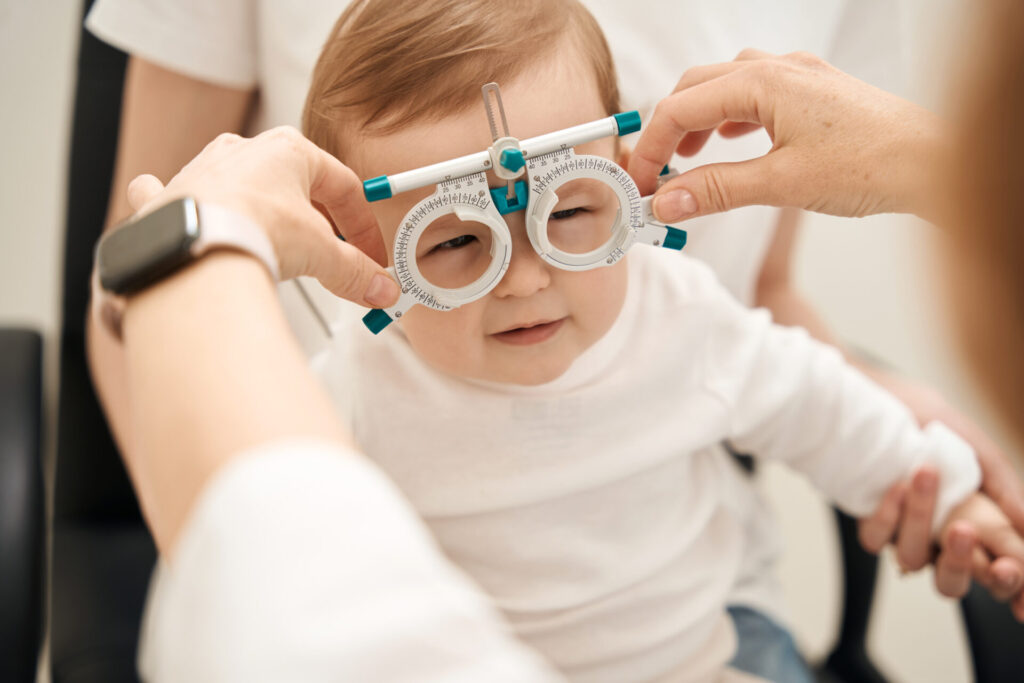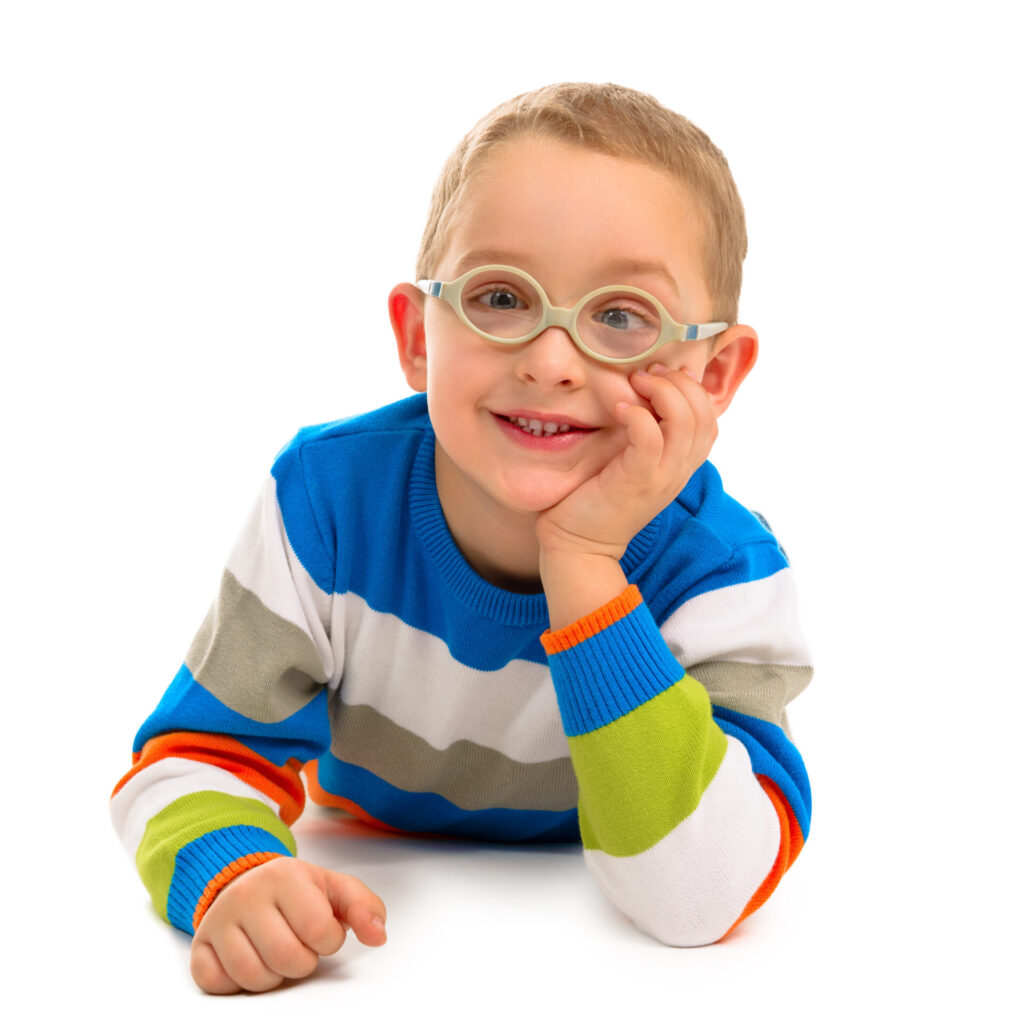School. After-school practices. Sporting events. Performances. Recitals. Checkups. Sick visits. As a parent, you know that it seems as if there is always an event or appointment to take your children to. During the hustle and bustle of life, ensure that routine eye exams for your children are on the agenda. Your child’s eyesight and ocular health are crucial components of their physical development, education, and success on the ball field or stage, and eye exams help ensure their eyes are in tip-top shape.
To know when your child should visit the eye doctor, we’re diving deep into eye development at various stages in infancy and childhood, providing recommendations for when to schedule your visits, and sharing what you and your child can expect during each exam.
Ocular Screening for Your Newborn
Babies are born with blurry vision but develop visual strength and clarity as they age. While newborns do not need to visit an optometrist or ophthalmologist, they should receive a basic eye exam from their primary provider. During your newborn’s checkups, their doctor will evaluate their eyes to check for basic function. This screening can include:
- Light testing: does your baby blink in response to a bright light?
- Pupil testing: do the pupils adjust to various amounts of light exposure?
- Tracking: can your baby visually track an object like the doctor’s fingers or a toy?
- Red reflex: do your baby’s eyes produce a red reflex (like red eyes in a photograph) when exposed to light?
If your newborn shows warning signs during the vision screening, your doctor may refer you to an ophthalmologist for further examination. Your doctor will also consider your family’s ocular history and may recommend a visit to the ophthalmologist if there is a history of strabismus, amblyopia, congenital cataracts, or other vision or ocular health issues.
What Vision Issues Can Affect My Newborn?
Everything that makes up the eyes—muscles, tendons, retinas, lenses, and everything else—grows rapidly during infancy. In fact, babies don’t see shapes and objects as three-dimensional until about month five due to how their eyes develop. During this development phase, there are normal eye motions or behaviors that can seem troublesome on the surface. These issues can include:
- Eyes that don’t seem to work together
- Eyes that do not track well
- Eyes that do not seem to focus
If your newborn baby is exhibiting any of these “warning signs,” don’t worry. The eye muscles are still strengthening, and the eyeballs are still growing, so some things may seem out of whack until the eyes grow strong enough to start working properly.
While vision issues are rare for newborns, it is possible to be born with conditions such as:
- Amblyopia
- Congenital cataracts
- Congenital glaucoma
- Retinoblastoma
- Strabismus
Your doctor’s newborn evaluation will reveal whether your child’s eyes are healthy or require further attention and observation.
Comprehensive Eye Exam for Your 6- to 12-Month-Old

After the newborn screening, your child’s next eye exam should happen between 6 months and 12 months of age, and it should be scheduled with a skilled optometrist or ophthalmologist. During this exam, your eye doctor will review previous test results and study your child’s eye development to ensure milestones have been reached and everything is on track.
During this exam, your eye doctor will perform similar tests to the newborn screening and will also include tests that evaluate:
- The alignment of the eyes
- How well the eyes move together
- How the eyes look both externally and internally
These evaluations do not test for visual acuity, but they do help ensure that the eyes are developing well and at the same rate as one another.
What Vision Issues Can Affect My 6- to 12-Month-Old?
Now that your child’s eyes have had some time to develop and strengthen, eye behaviors that were once considered a normal part of their development can indicate issues if they are still occurring.
Older infants can start showing clearer signs of binocular vision dysfunctions like:
- Amblyopia (one or both eyes that wander)
- Convergence excess or insufficiency
- Strabismus (eyes that point inward)
- Tracking issues
Your baby’s eye exam can help identify any warning signs so that you can start treatment, such as vision therapy, early.
Comprehensive Eye Exam for Your 3-Year-Old
Children 3 years of age should visit their eye doctor once again to ensure the eyes are still developing well and their ocular growth is on track.
During this exam, your child’s eye doctor will perform tests similar to the newborn and older infant exam. However, this one will likely include screening for:
- Visual acuity – your doctor will evaluate how well your child can see up close and at a distance. The test usually does not include a letter chart like standard acuity tests. Instead, your child will likely look at a chart with identifiable shapes, like squares, circles, hearts, and stars.
- Color blindness – your doctor will use certain tests to determine if your child is colorblind.
What Vision Issues Can Affect My Toddler?
Vision and ocular complications like strabismus, amblyopia, and convergence issues can begin to appear in your toddler, just as they can appear during older infancy. However, now is also the time when your child can show signs of refractive errors, such as:
- Astigmatism
- Nearsightedness
- Farsightedness
Your child’s eye exam will reveal any issues that may have developed by this point and will guide your optometrist or ophthalmologist toward the proper treatment or corrective solutions.
Comprehensive Eye Exam for Your 5-Year-Old
Just before your child begins kindergarten, it is wise (and recommended) to have their vision checked. This ensures they are fully prepared to step into the classroom and take in all the sights, including the chalkboard, their class work, and the teacher at the front of the room.
You can expect your child to undergo some of the previous tests, like eye tracking and alignment evaluations, during this exam. Plus, your eye doctor will perform thorough evaluations that analyze their visual acuity.
What Vision Issues Can Affect My 5-Year-Old?

Visual acuity issues and binocular vision dysfunctions can arise at any time. While it is rare to appear in years 5 or 6, problems like strabismus or amblyopia can still develop without previous warning signs. Refractive errors can develop at any point in a person’s life, including at age 5.
Eye exams are important at this time so that your doctor can catch any vision issues and prescribe the proper corrective lenses or treatment plans for your child.
Eye Exams for Children 5 Years Old and Older
If your child’s visual acuity and ocular health are sharp and on track, it is recommended to schedule eye exams every two years to monitor their development and catch any vision changes.
If your child has required treatment or vision correction before their 5th or 6th year, it is recommended to have their vision checked once a year for proper monitoring and necessary adjustments.
Set Your Child Up for Success With Routine Pediatric Eye Exams from Vision Eye Group’s Optometrists and Ophthalmologists.
From infancy to adulthood, our trusted eye doctors are here to care for your child and ensure their eyes are well cared for. We will evaluate your child’s eyes and provide any necessary corrective lenses or treatments needed to keep their development on track and their visual acuity sharp. We also offer referrals to reliable vision therapists or other needed professionals. Schedule your child’s eye exam today by calling 478-744-1710.
Related Articles
